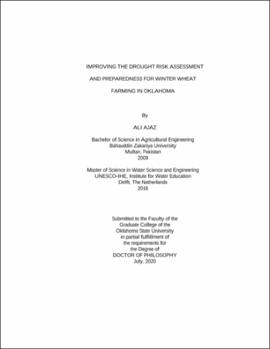| dc.contributor.advisor | Taghvaeian, Saleh | |
| dc.contributor.author | Ajaz, Ali | |
| dc.date.accessioned | 2023-04-20T18:24:46Z | |
| dc.date.available | 2023-04-20T18:24:46Z | |
| dc.date.issued | 2022-07 | |
| dc.identifier.uri | https://hdl.handle.net/11244/337440 | |
| dc.description.abstract | Droughts pose a persistent threat to agriculture in the Southern Great Plains (SGP). Oklahoma is a major contributor to dryland winter wheat farming in the SGP, acrop that is highly susceptible to drought episodes. Modern tools of environmental monitoring and crop simulations provide great opportunity to improve agricultural drought risk assessment and preparedness. However, in the wheat belt of Oklahoma, these modern technologies have been less utilized to understand the dynamics of droughtand its effects on winter wheat growth. There is an immediate need to investigate the prospective of advanced environmental monitoring networks and practitioner-oriented crop models to mitigate the impacts of dry periods on crop yield. The objectives of this study were to: 1) develop a new drought index using soil moisture and weather data for improved drought monitoring of winter wheat; 2) calibrate and validate a crop model and employ it to study the impacts of planting date and water availability at planting on theyield of dryland and irrigated winter wheat; and 3) apply the calibrated crop model across the winter wheat belt in Oklahoma to investigate the spatial variation in yield and itsdrought sensitivity. The development of a new drought index showed that soil moisture information in conjunction with reference evapotranspiration can improve the estimation of drought magnitude. Also, the new drought index correlated well with the winter wheat yield, showing its potential for agricultural drought monitoring for Oklahoma. Long-term crop modeling study for winter wheat in Oklahoma revealed that October planting dates usually provide better yields in comparison to September sowing. Moreover, the considerable impact of soil moisture at the time of sowing was noted on overall wheat yields, and the irrigation had noticeable positive effect on yield, especially in drought years. Gridded crop modeling helped understanding the spatial variation in potential dryland yields in wheat belt of Oklahoma. Furthermore, it was found that the winter wheat yield was highly correlated to drought in the months of March to May, and West Central climate division was highly sensitive to dry periods in Oklahoma. | |
| dc.format | application/pdf | |
| dc.language | en_US | |
| dc.rights | Copyright is held by the author who has granted the Oklahoma State University Library the non-exclusive right to share this material in its institutional repository. Contact Digital Library Services at lib-dls@okstate.edu or 405-744-9161 for the permission policy on the use, reproduction or distribution of this material. | |
| dc.title | Improving the drought risk assessment and preparedness for winter wheat farming in Oklahoma | |
| dc.contributor.committeeMember | Weckler, Paul | |
| dc.contributor.committeeMember | Alderman, Phillip | |
| dc.contributor.committeeMember | Gowda, Prasanna H. | |
| osu.filename | Ajaz_okstate_0664D_16861.pdf | |
| osu.accesstype | Open Access | |
| dc.type.genre | Dissertation | |
| dc.type.material | Text | |
| dc.subject.keywords | crop model | |
| dc.subject.keywords | drought index | |
| dc.subject.keywords | drought risk | |
| dc.subject.keywords | geospatial | |
| dc.subject.keywords | water management | |
| dc.subject.keywords | winter wheat | |
| thesis.degree.discipline | Biosystems and Agricultural Engineering | |
| thesis.degree.grantor | Oklahoma State University | |
